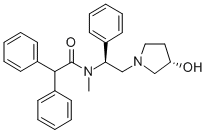SAFETY INFORMATION
| Signal word | Warning |
|---|---|
| Pictogram(s) |
 Environment GHS09 |
| GHS Hazard Statements |
H410:Hazardous to the aquatic environment, long-term hazard |
| Precautionary Statement Codes |
P273:Avoid release to the environment. P391:Collect spillage. Hazardous to the aquatic environment |
COMPUTED DESCRIPTORS
| Molecular Weight | 414.5 g/mol |
|---|---|
| XLogP3 | 4.1 |
| Hydrogen Bond Donor Count | 1 |
| Hydrogen Bond Acceptor Count | 3 |
| Rotatable Bond Count | 7 |
| Exact Mass | 414.230728204 g/mol |
| Monoisotopic Mass | 414.230728204 g/mol |
| Topological Polar Surface Area | 43.8 Ų |
| Heavy Atom Count | 31 |
| Formal Charge | 0 |
| Complexity | 531 |
| Isotope Atom Count | 0 |
| Defined Atom Stereocenter Count | 2 |
| Undefined Atom Stereocenter Count | 0 |
| Defined Bond Stereocenter Count | 0 |
| Undefined Bond Stereocenter Count | 0 |
| Covalently-Bonded Unit Count | 1 |
| Compound Is Canonicalized | Yes |
PRODUCT INTRODUCTION
description
Asimadoline is a proprietary small molecule therapeutic, originally discovered by Merck KGaA of Darmstadt, Germany. Asimadoline was originally developed to treat peripheral pain such as arthritis. Asimadoline is an orally administered agent that acts as a kappa opioid receptor agonist. It has shown encouraging clinical efficacy for the treatment of IBS in a barostat study in IBS patients and has the potential for treating other gastrointestinal diseases.
